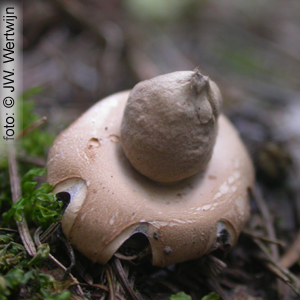
Photo: Elegant Earthstar
(Geastrum elegans)
Doubtful observation |
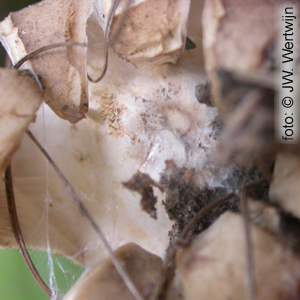
Photo: Elegant Earthstar
encrusted debris,
no scar, but with a pseudo-scar * |
Elegant Earthstar
(Geastrum elegans Vittad.)
NMV Ga 211010
This website's primary concern is the Amsterdam Area, incl. the pleistocene area Het Gooi and parts of the Northsea dunal coast |
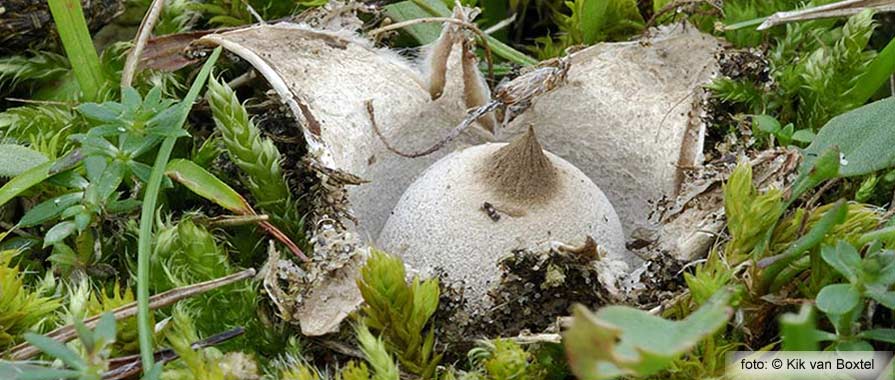
Photo: Elegant Earthstar (Geastrum elegans), Castricum October 2007,
in stark mossy short dunal grassland.
At this picture the earthstar looks as if the mouth-zone is fibrillose (later in development the mouth-zone becomes
clear Plicate-Furrowy), and already now the mouth-zone starts developing a conical shape.
On the upper-left picture that is not happened or a hungry snail just passed by. That is why that observation is doubtful.
|
|
|
Elegant Earthstar (Geastrum elegans)
|
Sessile Earthstar (Geastrum fimbriatum)
|
Felty Earthstar (Geastrum saccatum)
|
| Encrusted debris
|
yes
|
yes
|
no
|
| scar
|
no*
|
no
|
yes (2-4 mm)
|
| balloon (mooth-zone)
|
plicate-furrowy** high conic,
no court, no ring-furrow
|
fibrillose,
no court, no ring-furrow
|
fibrillose,
often with court and ring-furrow
|
| balloon (form)
|
higher than broad
|
globose
|
globose
|
* Explanation:
A scar is a slightly lighter spot at the bottom of the star-rays. This spot is the place where the earthstar in bulb-form was fixed to the mycelium-hyphes.
Even after drying, and years of storage, the scar stays visible. The field-mark " Scar" only exists for the group of basimycelyate earthstars.
From the group of earthstars with encrusted debris, there is only one with a scar, all the other species do not have a scar.
While breaking out encrusted debris, there is a chance to break out too much of the star-rays-bottom. In that case a pseudo-scar is formed.
This scar disappears at drying.
**Explanation:
Fibrillose and plicate-furrowy mouth-zones often develop during growing up.
Fibres and plica become sharper, deeper, higher upon maturing, riping, drying.
So, there are stages or phases in which it is not clear to see what is going on, like on the photo left-top on this page.
In such situations naming of the earthstar is hardly possible, and impossible from a picture like this. |
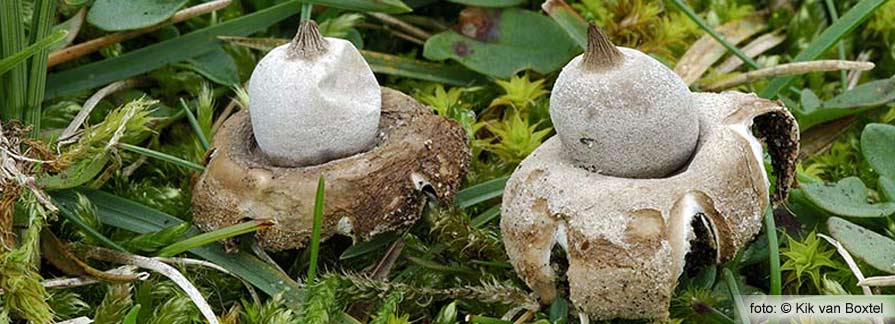
Photo: Elegant Earthstar (Geastrum elegans Vittad.), Castricum October 2007.
Older and more mature Elegant earthstars can have a high conical, plicate-furrowy mouth-zone, remarkable.
|
How to exclude mistakability:
- Look at the bottom of the earthstar
- Is it fixed in the ground (encrusted debris)?
- Does it have a scar at the bottom of star-rays ?
- Is there a felty layer at the bottom of star-rays
- If this is not helpful: dry the earthstar, and see what changes during the dry-process
|
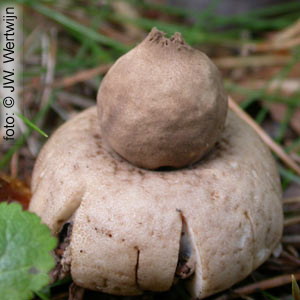
Photo: Sessile Earthstar
(Geastrum fimbriatum) |
.jpg)
Photo: Sessile Earthstar
encrusted debris, no scar |
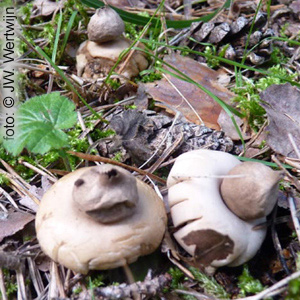
Photo: Sessile Earthstar
(Geastrum fimbriatum)
|
|
Habitat:
Calcareous and non-calcareous humousless dunes, at dry, often places with a lot of moss,
open dunes (Calluna vulgaris, rubus spec.), and along footpath-sides.
Often in the shadow of shrubbs, or at open places in more closed bushes.
|
|
Wood species:
Deciduous wood (Sea Buckthorn, Common Spindle Tree, Common Dwarf Willow, ligustrum vulgare, Hawthorn)
|
|
Regional:
Amsterdam Area: no.
Pleistocene area: no.
Northsea dunal coast: yes.
|
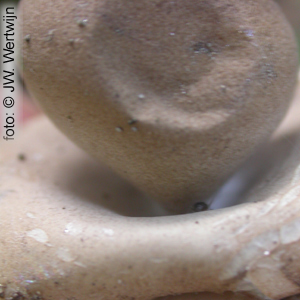
Elegant Earthstar (Geastrum elegans)
|
Looking under the skirt, it looks like a stem, but it is not.
It is a funnel-shaped balloon, without apophyse.
|
Elegant Earthstar Field-Marks:
Zie: Anatomy Genus Geastrum
- Species size: small
- Stem (visible under balloon): no, no apophyse
- Balloon in diameter: 5-12 mm.
- Balloon surface: young floury (fine cristalline), older bald
- Balloon younger color: grey
- Balloon older color: brown
- Balloon mouth-zone: plicate-furrowy, no cvourt, no ring-furrow, (often) high conic
- Balloon mouth-zone: color darker than ballon color
- Star-rays number: 5-8
- Star-rays-diameter: 1 - 3,5 cm
- Star-rays-thickness: fresh upto 1.5 cm thick
- Star-rays-top color: young creme, older brown
- Star-rays: encrusted debris
- Star-rays: no scar
- Star-rays: saccate, non-hygroscopic
- Star-rays: bottom color beige
|
Literature:
Chrispijn, R. ed. (1999), Champignons in de Jordaan (De paddenstoelen van Amsterdam), Schuyt en Co, 162-163.
Hansen L. & H. Knudsen (1997), Nordic Macromycetes, Vol. 3, Heterobasidioid, aphyllophoroid and gasteromycetoid basidiomycetes, Kopenhagen, 1997, 444 pp.
Jalink, Leo M (1995) De aardsterren van Nederland en België, Coolia 38 Supplement.
www.mycobank.com
|
Top
 Switch to Dutch (NL) Switch to Dutch (NL)
|